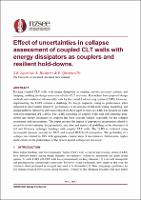| dc.description.abstract | Rocking coupled CLT walls with energy dissipaters as couplers provide increased stiffness and damping, enabling the design realisation of taller CLT structures. Researchers have proposed design methods and conducted sub-assembly tests for this lateral load-resisting system (LLRS). However, implementing the LLRS remains a challenge for design engineers owing to performance when subjected to uncertainties related to; performance in the absence of full-scale testing, modelling, and design methods. Moreover, previous research on these types of walls as LLRS was focused on walls with post-tensioned (PT) cables. The LLRS consisting of coupled walls with self-centering hold-downs and energy dissipaters as couplers has been sparsely studied, especially for the collapse assessment with uncertainties. This paper presents the impact of appropriate uncertainties related to record-to-record variation, design methods, test data, and numerical modelling on the robustness of 6,8 and 10-storey archetype buildings with coupled CLT walls. The LLRS is evaluated using incremental dynamic analysis for MCE and beyond MCE-level earthquakes. The probability of a collapse was limited to 10% with appropriate consideration of uncertainties. Furthermore, higher mode effects on the performance of the system against collapse are discussed. | |

